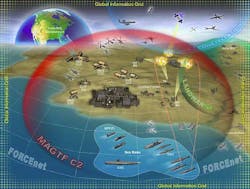Navy chooses Progeny Systems, Decisive Analytics to process real-time battlefield information
Officials of the Office of Naval Research (ONR) in Arlington, Va., have announced contracts for the Exchange of Actionable Information at the Tactical Edge (EAITE) program, which seeks to forge major advancements towards a user-oriented battlefield world view for tactical and operational situational awareness and understanding.
The EAITE contractors are Progeny Systems Corp. in Manassas, Va.; and Decisive Analytics Corp. in Arlington, Va. Progeny won a $2.1 million contract, while Decisive Analytics won a $2.3 million contract.
The EAITE program's goal is to package and disseminate timely and usable operational and intelligence data to U.S. Marine Corps warfighters in expeditionary units.
The program has three technology thrusts: data conditioning involving software and firmware; actionable information tactical applications software; and network adaptive communication services software. Progeny and Decisive Analytics will tackle one of these three areas -- which ones is not clear.
Naval forces must be able to acquire, process, and disseminate high-value information quickly via ad-hoc networks to speed battlefield decision making, ONR experts say. When it comes to Marine Corps expeditionary units attack enemy beaches, this is not possible today.
Current information products are manually processed and not timely. Sensor and source raw data is timely, meanwhile, but overwhelms users and network capacity. The problem also is getting worse. Today's expeditionary forces use many sensors, radios, and computers, yet information-management and dissemination capabilities have not kept pace.
Instead, Navy researchers want to automate data processing using adaptive data compression, format conversion, and data orchestration for mediation. Researchers also want to enable the warfighter to search high-value target databases.
That's where Progeny Systems and Decisive Analytics come in. The companies will pursue applied research to help make the most of limited sensors, computers, and communications as efficiently as possible.
The companies will perform research in data conditioning; actionable information tactical applications (AITA); and network adaptive communication services (NACS).
Related: Data dissemination and validation on the battlefield
Data conditioning involves conditioning data as packages of information at or near the sensor and command-and-control nodes using machine understanding, algorithms, and power-efficient processing. Navy researchers want the ability to trace the origins of information; sensors that automatically format products; and generate intelligence reports based on network capacity.
Actionable information tactical applications (AITA) involves the ability to create information products automatically fusing content from individual sensors. Researchers want a work flow manager to orchestrate services to generate products; develop the semantics that enable a machine to understand content; and generate custom reports automatically for specific missions.
Network adaptive communication services (NACS) involves developing the ability for battlefield networks that know their condition and workload such that they can rank information in order of importance for dissemination.
For more information contact Progeny Systems online at www.progeny.net, Decisive Analytics at www.dac.us, or the Office of Naval Research at www.onr.navy.mil.
